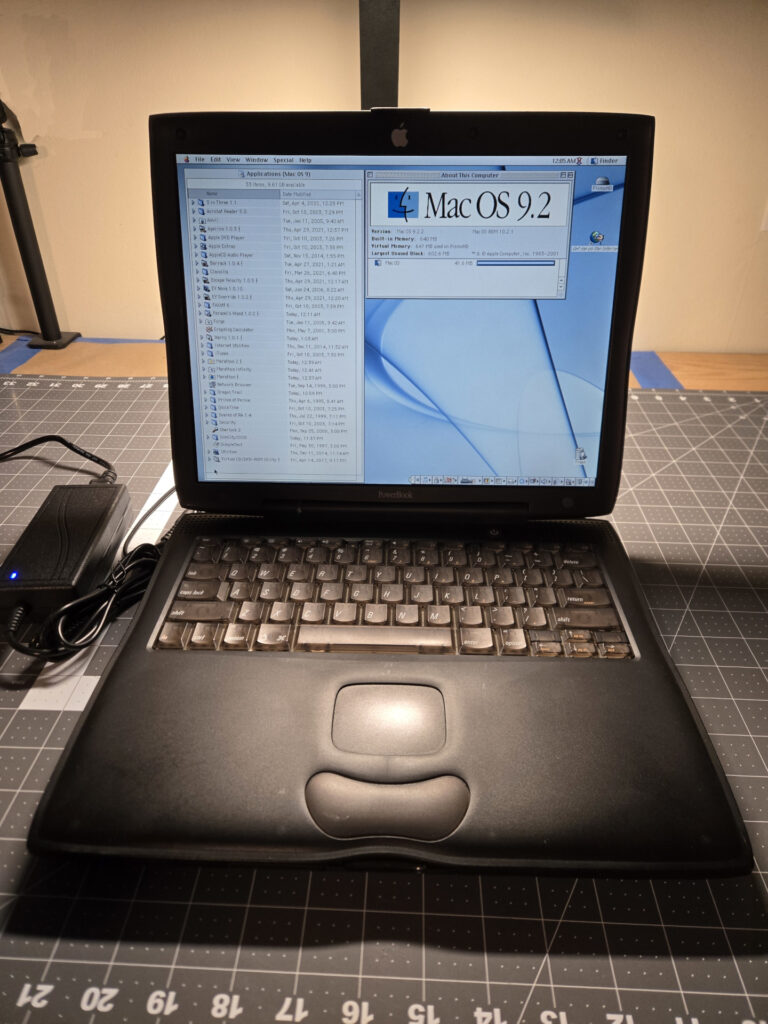
I’ve wanted one of the curvy bronze-keyboard G3 Powerbooks since they were new – I’ve always been kind of taken by the design language (half business, half iBook). I got to play with a university-owned Wallstreet for a while as a kid, so I remember them beyond looking in catalogs, and uh… I really like a bunch of classic Mac games and want a convenient late-classic machine to run them natively, because a few are glitchy in emulation.
So, I occasionally lowball bid promising auctions when one comes up somewhere. A few months ago (in late February) there were a succession of them on ShopGoodwill, and I tossed a $50 max bid on a Pismo in the 500MHz/128MB/12GB/DVD configuration in unknown electrical and OK but not perfect cosmetic condition. And, surprisingly, won. It ended up being about $67 with shipping/handling/tax/etc. Since working condition examples tend to be around $200, this seems like a decent deal. It survived the typically awful shipping, and, in long form below, it turned out to be a good buy.
The Pismo is an interesting machine, it was the last of the G3 Powerbooks from 2000, and (by product name) is just “Powerbook” – unlike all the earlier versions, it didn’t technically have the “G3” suffix, it was the beginning of the stupid Jobsian non-descriptive names.
There are a few minor downsides to a Pismo relative to some of the other members of the family – they dont have SCSI and won’t accept a native floppy drive in their hotswap bay, so they aren’t as good as bridge boxes, and they won’t run Rhapsody – I believe the last supported machine is the PDQ/Wallstreet II model. But, it’s among the most powerful and compatible late-classic portables (Strictly the “TiBook” G4s are the most powerful portable that will run 9.2, but I always found them ugly, and they generally didn’t mechanically age well so they are now super fragile), is late enough for FireWire, etc.
It didn’t come with a PSU, and those 3.5mm TRS in 9mm jacket 24V PSUs that the G3 (and a several earlier) Powerbooks used are obnoxiously expensive, and likely to be bad at this point. Likewise, the only universal power adapter in my collection with a 3.5mm TS option has fixed polarity backwards from what the Powerbooks expect (it grounds the sleeve and powers the tip, Powerbooks want +24 on the sleeve and Gnd on the Tip).
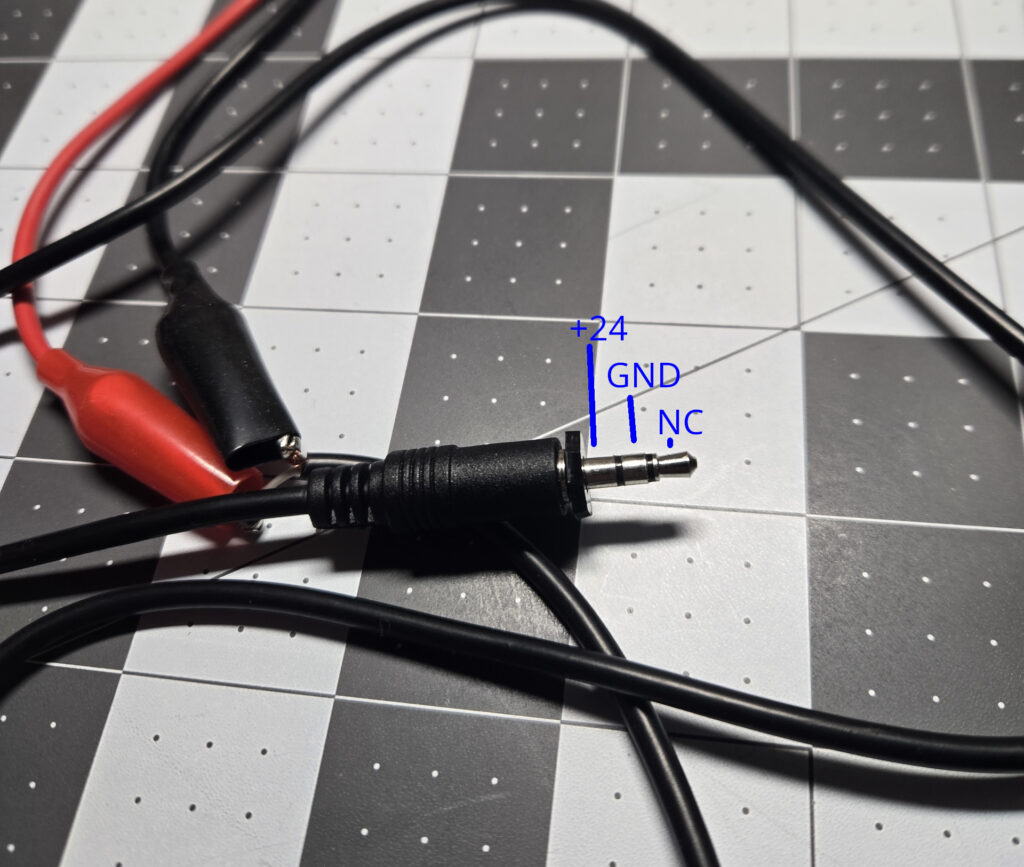
So I saw some posts on 68kMLA and Macrumors showing how the pinout works, and rigged up a power adapter out of an old cut-off audio cable and a piece of plastic around 1.5mm thick (I think it’s actually some .060″ HDPE stock leftover from another project) with a 3.5mm hole drilled in to it to prevent over-insertion. Initially I tested it from an adjustable bench supply. Later, I picked up a cheap 24V brick with a barrel-to-screw-terminal adapter to get the noisy PSU fan and alligator clips out of the mix.
…In related good news, the reverse protection on the power inlet is good (as you’d hope for a connector that wipes the contacts) so the brief incident with setting it up backwards didn’t do any damage. It seems to draw about 12-16W under normal operation.
After getting power sorted, the machine seems surprisingly fine. I do have what I think is a minor power regulation issue that I haven’t managed to sort, but it doesn’t prevent the machine from being usable.
The Pismo is known for failing to boot with a dead PRAM battery, but boots reliably (without RTC) with it removed. The PRAM battery in this unit will hold charge for a few days, so I can connect it while I’m using it, but if I leave it for a while I have to flip up the keyboard and unplug it to get the machine booting.
Configuration wise, it has a factory AirPort card, which is nice, though they can’t do WPA2 so you can’t connect them to most modern networks. The only really odd thing about the configuration is there isn’t a battery in it; it has the “weight saver” blank insert in one bay and a factory DVD drive (that works … except for said power problem) in the other. It would be nice to have an operable battery, but no battery is better than leaked/swollen battery.
The original 12GB 2.5″ IDE disc is present, with the usual assortment of personal information, pornography (including some text smut that was probably crudely written by the owner), and broken software you find on old machines you buy online. It came with a period 10.3.9 install with an oddly fucked up classic environment. It looks like it was used fairly heavily until ~2003 as the successor to another Mac, then intermittently until ~2006, though in the last few years the primary application seems to have been playing audio books. Then it apparently sat for almost 2 decades without any major ill effect.
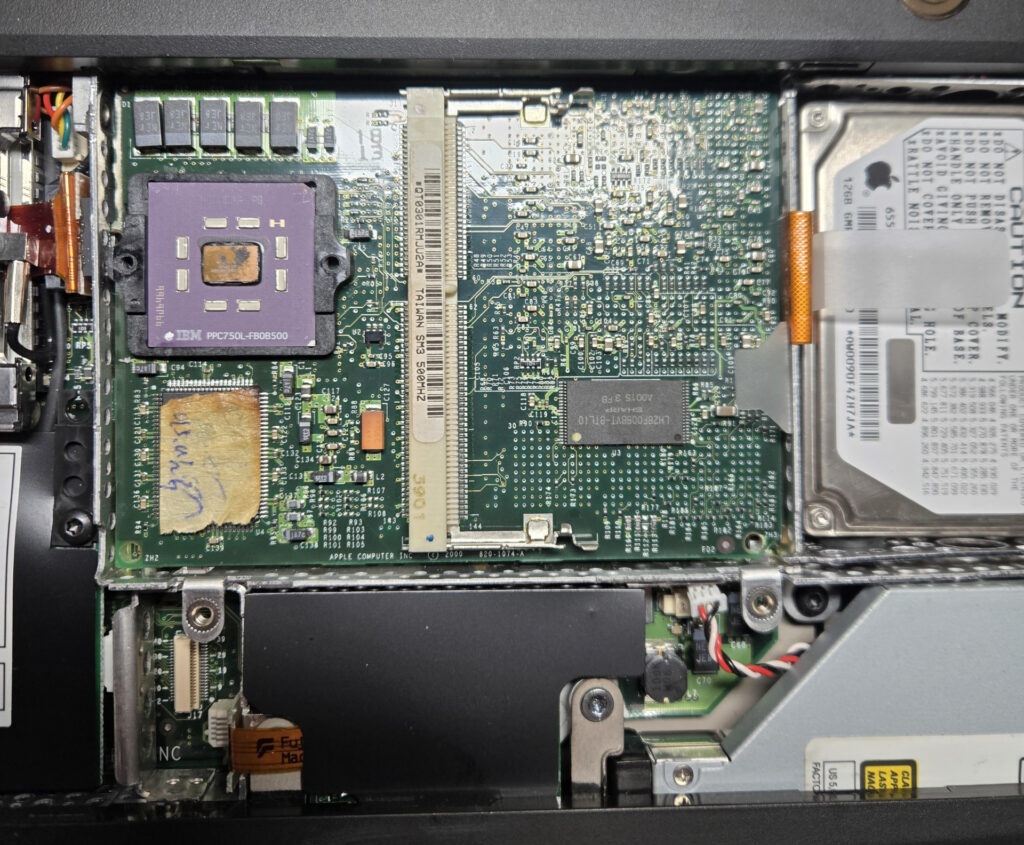
I did pull the CPU module and replace the heatsink compound – which looked almost scorched – with some AS Ceramique since it’s always a safe choice. I blew some contact cleaner through both sides of the mezzanine at the same time since that seems to be a possible problem with these machines.
To wipe and refresh the disc, I burnt a 10.4 retail DVD from an image I had around, I mostly want it for OS9 (…because Barrack doesn’t run properly in Classic or most emulators), but ran into crashes while booting from the optical drive. I also burnt a OS 9 Lives 9.2.2 universal CD and it has the same issue – reads in a booted OS, but the machine suddenly dies when trying to boot from it.
I swapped the drive for a different ATAPI drive I had around and it continues to be unstable, my working theory is a power issue when spinning the optical drive. The power distribution board on Pismos is known to go out, but it’s an ordeal to extract, and there isn’t any documentation on recapping it, so I’m letting it go for the time being and switched tactics.
The optical drive problem isn’t too serious because I have both an aluminum PowerBook G4 bought under similar circumstances which will do FireWire target disc mode, and (even better) an old USB2+FireWire IDE disc enclosure that I can format HFS+, mount via USB to a modern Linux system, and via Firewire on the old Mac that I’ve used for most of my software loading.
I ended up deciding it just wasn’t worth dealing with an OS X image on this thing since I have other machines for that, and just installed the OS 9 Lives 9.2.2 image. It runs well on the hardware, and supports the software I’m interested in.
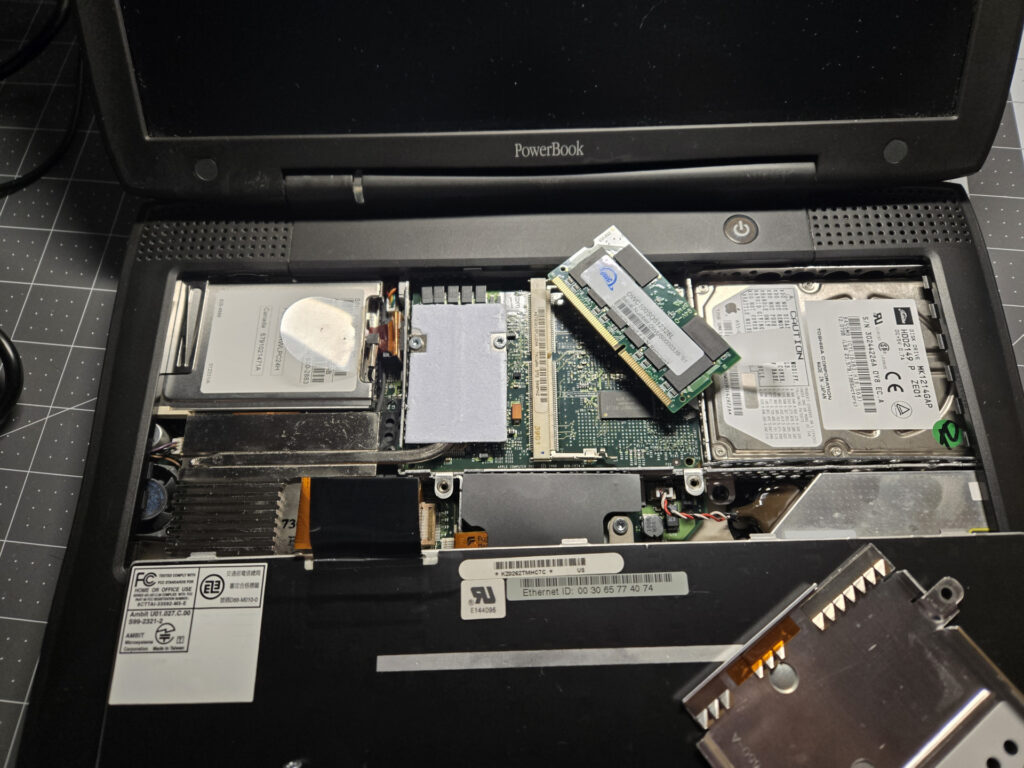
Once I got it going, I saw that OWC will still sell you a suitable 512MB PC100 SODIMM for like $15 so I bumped the RAM to a period-decadent 640MB.
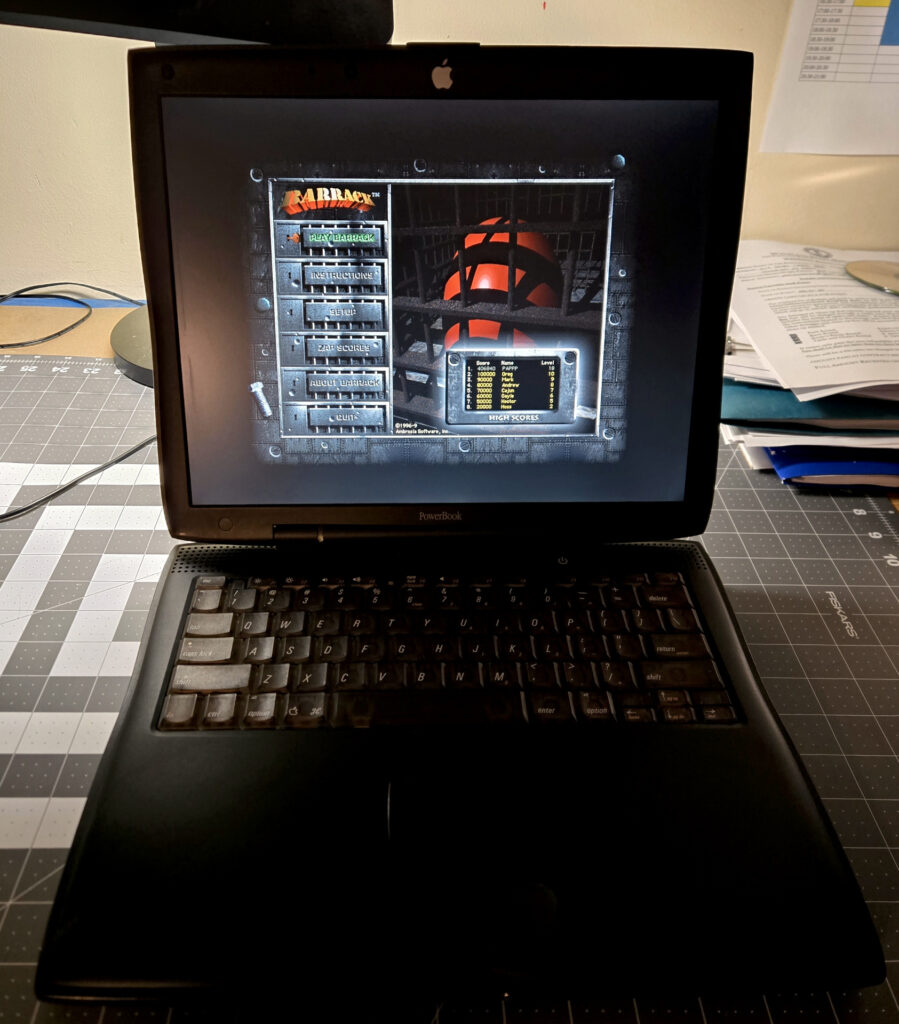
And it works. I didn’t have to do any major work to it, or source any replacement parts. I have a minor bug where the volume setting sometimes gets ignored and it becomes very loud, and I’ve been leaving the optical drive disconnected to avoid whatever stability problem is going on there, but it has a large catalog of period-appropriate and slightly earlier software – especially most of the Ambrosia Software games catalog including things like Barrack and Ferazel’s Wand that tend to be buggy under emulation.
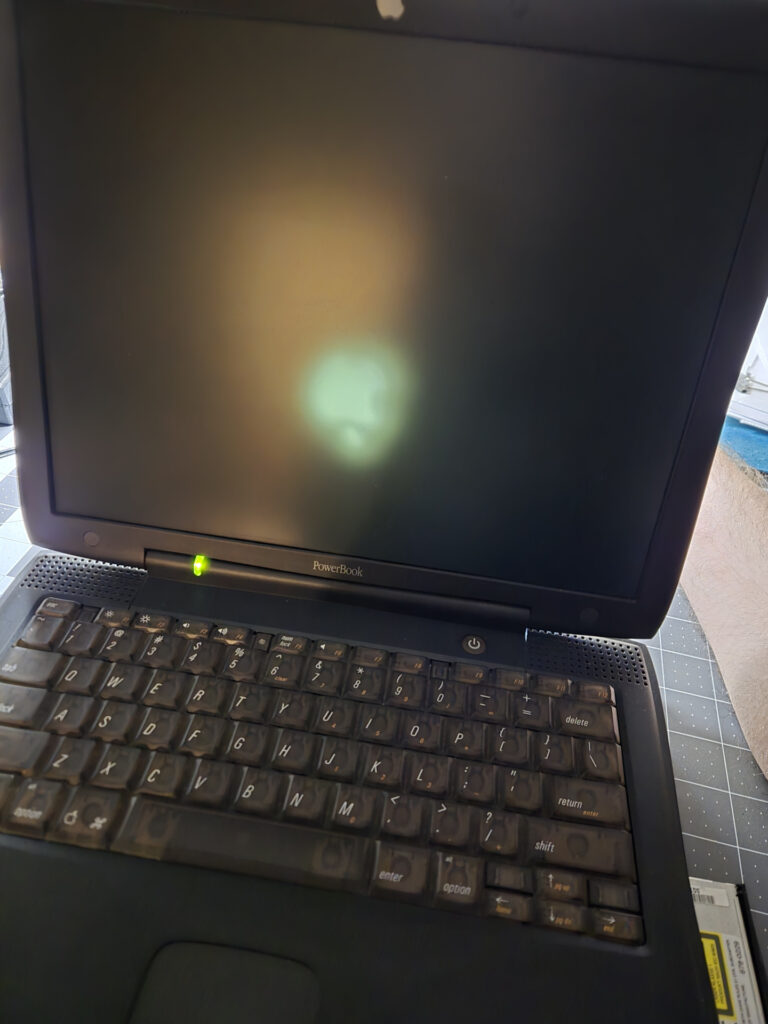
There were a few fun observations. I’d forgotten how loud these machines were. The hard drive alone is as loud as my modern machines when their fans are screaming under load. I also didn’t realize that the early glowing-apple-logo Powerbooks glow due to a transparent spot in the back of the display backlight; I thought it had a screen bruise until I realized it was just the lamp behind shining through.
It’s not a wildly exotic machine, or adding any new environments to my collection, but it’s a solid, very convenient late-classic Mac for doing late-classic Mac things. It wasn’t terribly expensive or difficult to get there.

